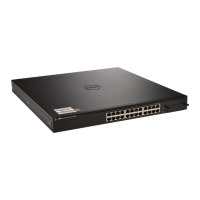Configuring Data Center Bridging Features 831
console(config-if)#switchport mode trunk
5
Exit interface configuration mode for the range of interfaces.
6
Enter interface configuration mode for the CNA-facing ports and
configure the DCBx port role as auto-downstream. This step automatically
enables PFC on the ports.
console(config)#interface te1/0/1-3,te2/0/1-3
console(config-if)#lldp dcbx port-role auto-down
console(config-if#exit
7
Enter Interface Configuration mode for the ports connect to an FCF on
both switches in the stack to configure the DCBx port role as auto-
upstream.
console(config)#interface te1/0/16-17,te2/0/16-17
console(config-if)#lldp dcbx port-role auto-up
8
Set the FIP snooping port mode as
fcf
to indicate that these ports are
connected to a Fibre Channel forwarder.
console(config-if)#fip-snooping port-mode fcf
console(config-if)#exit
9
Optionally, use the FIP snooping show commands to verify the
configuration, view FIP snooping sessions, and view information about the
ports that are connected to end nodes or FCFs.
Enhanced Transmission Selection
Networks classify and prioritize traffic to provide different service
characteristics to end user traffic flows. Administrators may wish to guarantee
or limit bandwidth for certain traffic, ensure lossless behavior for other traffic,
and control the queue discipline/drop characteristics for best-effort traffic.
Additionally, it is desirable for a switch to support sharing bandwidth among
bursty sources while still enabling prioritization of time-sensitive or
management traffic that requires minimum latency.
Enhanced transmission selection (ETS) provides uniform management for
sharing bandwidth between congestion managed and traditional classes on a
single bridged network. Using priority-based processing and weight
allocations, Traffic Class Groups (TCGs) carrying different types of traffic
such as LAN, SAN, and management traffic can be configured to provide
minimum bandwidth guarantees, unused bandwidth sharing, and lossless or

